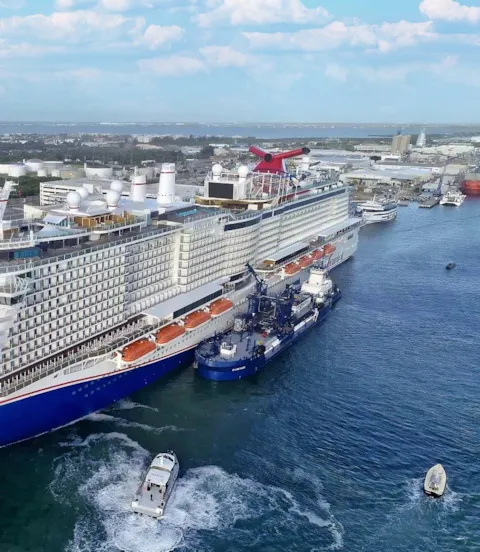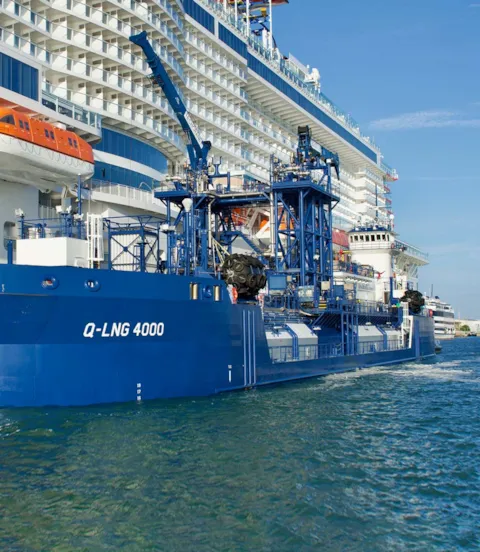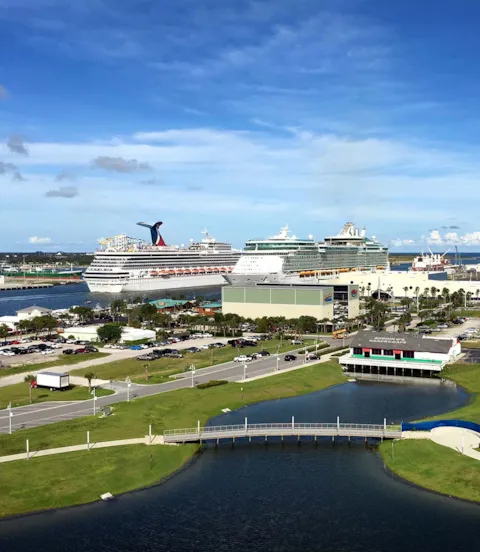Port Canaveral is the first US seaport to provide LNG bunkering for cruise vessels
Port Canaveral in Florida, a major home port for cruise vessels, is the first US cruise port to provide LNG bunkering services, securing a competitive advantage as the LNG-ready fleet continues to grow.
On 9 June 2021, a cruise vessel bunkered LNG at Port Canaveral, Florida for the first time. It was the inaugural visit of the Mardi Gras, the first cruise ship in the Americas powered by LNG, to her new home port. Moored at Terminal 3, which had been newly built to accommodate the gigantic, state-of-the-art vessel, she received 2,667 cubic metres of LNG from a custom-built bunkering barge.

LNG bunkering as a competitive advantage
Port Canaveral, located on the same peninsula as the legendary Kennedy Space Center, is the first seaport in the United States to provide LNG bunkering to cruise ships, a key accomplishment for a comparatively small port with a strong footprint in the cruise segment, says Captain John W. Murray, CEO and Port Director of the Canaveral Port Authority.
The very first cruise ship arrived here in September 1964. “Carnival Cruise Line was the first company, Royal Caribbean and Disney Cruise Line came a few years later and more are coming. They all are great partners of ours,” says Murray. Logging more than 900 cruise calls a year, Port Canaveral is the largest cruise port in the world in terms of passenger throughput.
“As a port authority, we are the medium that pulls all the right parties together to make things happen,” the seasoned former shipmaster explains. “We had the desire to make LNG happen early on. Today, both Carnival and Disney Cruise Line are operating LNG-powered vessels out of Port Canaveral.”

A home port for the largest cruise vessels
Port Canaveral was completed as a man-made port in 1953. Considering the limited space of only 445 hectares available on the narrow peninsula and all the environmental restrictions in place to protect Florida’s unique biosphere, every expansion project is a challenge, Murray adds. Furthermore, there are safety zones ships must avoid during rocket launches. “We work very closely with the U.S. Coast Guard. Together, we were able to update and reduce the safety zones significantly thanks to technology advances. This makes life easier for all the ship traffic in and around our port.”
John W. Murray joined the port seven years ago, coming from the cargo side of the world, as he puts it. “While learning about the cruise business, I took note of all the newbuilds out there and the high number of LNG-powered ships. We realized that if we were ever going to see those ships, we better figure out how to provide LNG bunkering.” A new pier for the Mardi Gras was completed in record time and by the time the majestic vessel was delivered, Port Canaveral had secured its position as her home port thanks to the availability of LNG.

Educating the public about LNG safety
Murray considers LNG as the cleanest-burning fossil fuel and the best option for the cruise industry today. Regarding fuel safety, he says, it is important to educate the public. “The one we convinced right up front was our fire chief who had once said it would never happen at Port Canaveral. When we told him about our LNG plans, he started to learn about it and got the appropriate training. He is now the biggest proponent for LNG we have.”
Port Canaveral’s fire department operates a dedicated LNG fire training academy. “Many mariners who will be working on LNG ships in the United States are trained there,” Murray points out. One of the lessons involves a big cauldron full of LNG that a trainee is asked to set on fire. “They discover that they cannot do it. There is a very small temperature range in which LNG will start burning and when it finally does, it doesn’t explode like gasoline but lights up very slowly. Once the trainees see all this they have an entirely different understanding of it.”

The shore power challenge
A large number of LNG-ready cruise and other ships are currently under construction; DNV alone is overseeing an order book of more than 300 LNG-ready vessels, says Jan Solum, DNV Area Manager for the North American East Coast. A development Port Canaveral is likely to benefit from, but there are also challenges.
Cruise ships are increasingly equipped to use shore power to allow them to turn their engines off entirely while at berth, says Solum, but few ports around the world can satisfy the enormous energy hunger of today’s giant cruise ships. Looking at where that potential shore power might come from, Murray has mixed feelings: “About 70 to 73 per cent of our power plants in Florida use natural gas; the rest is oil, nuclear power and coal. Using oil and coal as energy sources instead of LNG while giving the ships emission credits for doing so doesn’t make environmental sense,” he points out.
“Royal Caribbean’s Wonder of the Seas, for example, has around 7,000 guests on board and another 2,500 crew. That is close to 10,000 people to be supplied with electricity. The current electricity grid in Florida cannot fulfil that need without building new substations. It would probably cost upwards of 200 million dollars to electrify our six terminals and we cannot count on federal funding. Even with electrical connections available, the grid would not be able to support six ships at the same time. How are they going to decide which ship is allowed to plug in?” Nevertheless, Murray says, the dialogue with the cruise lines and coordinated efforts to make shore power available continue.

Other alternative fuels not in focus yet
Regarding other alternative fuels, the Port CEO believes that time will tell where to put the focus: “We are staying current with the technologies. I personally think that when I see our Florida power company convert some of their main power plants to ammonia or hydrogen, then we will start looking into these fuels for the marine environment. But since the shoreside plants are continuing to use natural gas, I think LNG is going to be the standard for the foreseeable future.”
The reason LNG works so well for cruise ships is that they return to their home ports and the source of their fuel about every 7 to 14 days, explains Murray, while cargo ships do not operate on similarly regular schedules. With more LNG-powered cruise vessels expected to make Port Canaveral their seasonal or year-round home port in the coming years, the demand for LNG will increase, strengthening the position of the port.

Attracting new business
The availability of LNG is not the only reason cruise lines like Port Canaveral. “There is something very unique that we do: We are a provisioning port for several cruise lines. Ships coming out of New York City and Baltimore, where it is very expensive to stock provisions because big trucks cannot run in New York City, first pick up their passengers in those ports and then come to Port Canaveral for provisioning before continuing their journey.” Another reason Port Canaveral is a very significant economic driver for central Florida.
“Through the pandemic, we looked very hard at ways to improve our product,” says Murray. “Meanwhile, we have noticed a change in passenger behaviour: People who used to travel to Miami to board cruise ships are now driving to Port Canaveral because it is easy to reach by car and saves them four hours. More people are coming by car than by plane, so we have been investing in additional parking facilities.”
The nearby Kennedy Space Center adds a point of attraction, says Murray: “The frequency of rocket launches has increased significantly. When you board a cruise ship at Port Canaveral today, you have a pretty good chance of witnessing a launch.”
The demand from cruise companies keeps growing and new partners have joined, including MSC. “All these cruise lines have plans for larger assets at Port Canaveral over the coming years,” says Murray. “And yet another brand that has never called here before will be calling from 2024 – watch the news!”

- Carnival Cruise Line
- Jared on Flickr, CC BY 2.0
- Photo by SpaceX on Unsplash